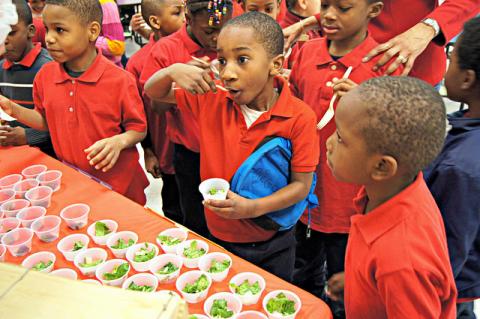
I live in an agricultural community, surrounded by apple orchards. We frequent the weekly farmer's market, garden (a lot, as you'll notice from my other posts) and in general my family really embraces the importance of eating fresh, healthy and local. So I'm a natural fan of Farm to School programs, and getting kids familiar with their food system in general.
October is Farm to School Month, making it a great time to explore how the program does all of the above, and more. Here's what you need to know:
The Basics: USDA launched the Farm to School Program in 2000. It was first authorized in the 2004 Child Nutrition Reauthorization, and formally funded with $5 million in the 2010 Child Nutrition Reauthorization. Current demand for Farm to School funding is more than 5x higher than what's available, so the newly proposed Farm to School Act of 2015 - which is part of the next Child Nutrition Reauthorization - would increase funding to $15 million. The Act would also include preschools and summer feeding programs, increase access among tribal schools, and more.
Farm to School programs include one or more of the following elements:
- Procurement: Purchasing and serving local foods
- Education around agriculture, food nutrition and health
- School gardens
USDA grants provide many kinds of support for Farm to School programs, ranging from "training, planning, and developing partnerships to creating new menu items, establishing supply chains, offering taste tests to children, purchasing equipment, planting school gardens, and organizing field trips to agricultural operations," according to the USDA website. And funding isn't just available for schools. Grantees "include schools and districts (large and small, rural and urban), Indian tribal organizations, agricultural producers or groups of agricultural producers, non-profit entities, and state and local agencies."
The program has fueled amazing results, from boosting local economies to inspiring kids and families to eat better. Check out these stats from the National Farm to School Network:
- Schools across the country spent almost $600 million on local foods during the 2013-14 school year, according to the second USDA Farm to School Census. That's over $200 million more than was spent two years prior.
- More than 42,000 schools are involved in Farm to School activities.
- Recent data furthermore shows that school districts participating in the program experience at least one of the following: greater acceptance of the new meal pattern (i.e. healthy meal standards), lower school meal program costs, reduced food waste, and increased participation in school meals.
- Outcomes also include improvement in student eating behaviors, enhanced academic achievement, improved social skills and behavior, increased income for local farmers, increased community awareness about purchasing local foods, and increased parent ability to incorporate healthier foods in family diets. And each dollar invested in farm to school programs stimulates an additional $2.16 in local economic activity.
If you're a participating school, there's still time to submit your feedback on your program's success here.
So how can you get involved? The National Farm to School Network is a great resource, and offers helpful tips on getting started, success stories, resources and more. They recommend:
- Identifying realistic goals for your Farm to School program
- Create a team within the school to get the program running, and
- Promoting the work in the school and community
There are just so many wins here, and reasons to get involved. Does your school participate in Farm to School? We'd love to hear about your experiences and successes in the comments below!
Photo credit: USDA. Used under Creative Commons license.



The views and opinions expressed in this post are those of the author(s) and do not necessarily reflect those of MomsRising.org.
MomsRising.org strongly encourages our readers to post comments in response to blog posts. We value diversity of opinions and perspectives. Our goals for this space are to be educational, thought-provoking, and respectful. So we actively moderate comments and we reserve the right to edit or remove comments that undermine these goals. Thanks!